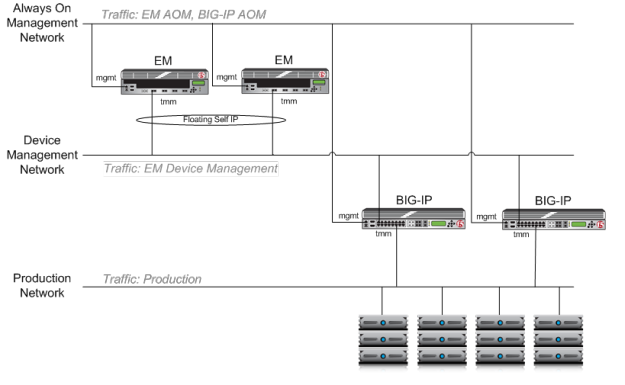Applies To:
Show Versions
Enterprise Manager
- 3.1.1
Overview of Enterprise Manager
Enterprise Manager is an appliance that helps you streamline the administrative tasks associated with managing multiple network devices. These administrative tasks include: performance monitoring, software installation and upgrades, configuration archival and restoration, certificate monitoring, security policy management, software image storage, and user account management. Enterprise Manager works in many types of network topologies, including those in multi-tiered configurations containing multiple firewalls.
You can use Enterprise Manager to manage networks with devices running the following software.
- BIG-IP system version 9.3 and later
- BIG-IP Local Traffic Manager Virtual Edition (VE) version 10.2 and later
- BIG-IP Secure Access Manager version 8.0 and later
- WANJet version 5.0 and later
- Enterprise Manager version 1.0 and later
Additional resources and documentation for Enterprise Manager
You can access all of the following Enterprise Manager documentation from the AskF5 Knowledge Base located at http://support.f5.com/. The procedures and examples described in all documentation and online help are written for administrator-level users with full access (non-restricted) privileges to Enterprise Manager.
| Document | Description |
|---|---|
| Enterprise Manager Getting Started Guide | This guide provides you with the basic concepts and tasks required to set up your Enterprise Manager and start managing devices. |
| Enterprise Manager: Monitoring Network Health and Activity | This guide contains information to help use iHealth for diagnostics purposes, monitor log events using LogIQ, track certificates, create alerts for events, run reports, and manage statistics storage. |
| Enterprise Manager: Working with Changesets and Templates | This guide provides information specific to working with changesets and templates. |
| Enterprise Manager: Managing Configuration Files | This guide contains instructions about how to store configuration data (UCS), including how to create an archive schedule, as well as information about restoring a UCS archive and comparing configurations. |
| Platform Guide: Enterprise Manager 4000 | This guide includes Enterprise Manager system hardware platform specifications, installation instructions, and important environmental warnings. |
| Release notes | Release notes contain information about the current software release, including a list of associated documentation, a summary of new features, enhancements, fixes, known issues and available workarounds, as well as installation and upgrade instructions. |
| Solutions and Tech Notes | Solutions are responses and resolutions to known issues. Tech Notes provide additional configuration instructions and how-to information. |
About incorporating Enterprise Manager into your network
You incorporate Enterprise Manager into your network as you would any F5 Networks device. However, because it requires bilateral communication with each device for successful management, Enterprise Manager must have open communication with your devices and be able to translate a device's IP address into an address it can use. The most common network configurations for address translation are:
- Tiered network, BIG-IP Local Traffic Manager performs address translation
- Where a device manages load balance requests for multiple devices and translates the IP addresses for those devices through a firewall
- Tiered network, a SNAT performs network translation
- Where a device (located in front of Enterprise Manager) load balances requests for multiple devices, and a SNAT translates the IP addresses for those devices
Ports required for two-way communication
For Enterprise Manager to properly manage devices, the following ports are open by default to allow for the required two-way communication.
| Open Port | Purpose |
|---|---|
| 443 | For communication between managed devices and the Enterprise Manager system, for the purpose of device management. |
| 4353 | For communication between Enterprise Manager and a managed device's big3d agent, for the purpose of statistics collection. |
| 3306 | For communication between Enterprise Manager and a remote statistics database, for the purpose of storing and reporting statistics. |
About best practices for management network topology
Device communication and management is performed through the following interfaces.
- Traffic Management Microkernel (TMM) interfaces
- For each of the following processes, you must dedicate a TMM interface to perform:
- Application traffic and load balancing
- Communication between Enterprise Manager and managed devices
- Communication between systems in a high availability configuration (for both static and floating self IP address support)
- Management (MGMT) interface
- Used by F5 devices for administrative traffic and for the Always-On Management (AOM) subsystem, which enables you to manage a system remotely using SSH or serial console, even if the host is powered down. Devices do not forward user application traffic, such as traffic slated for load balancing, through this interface.






